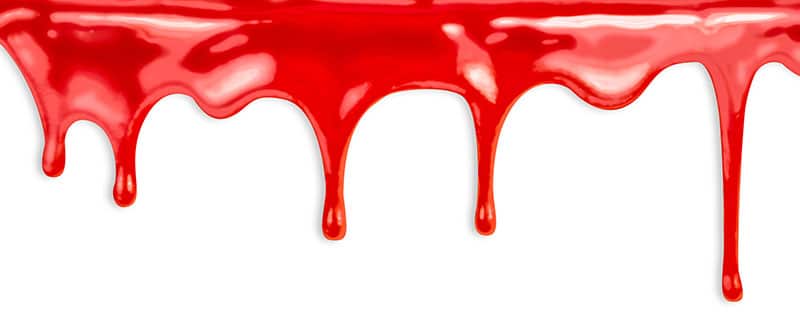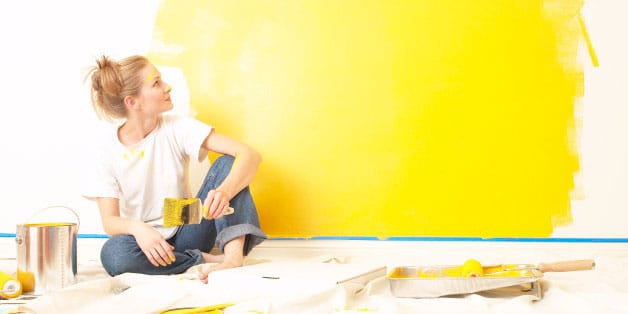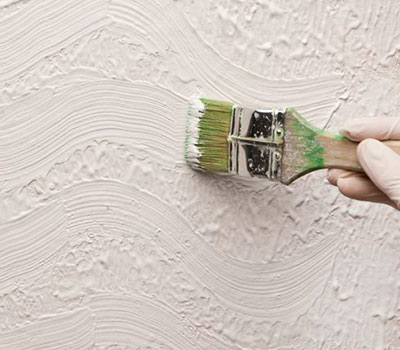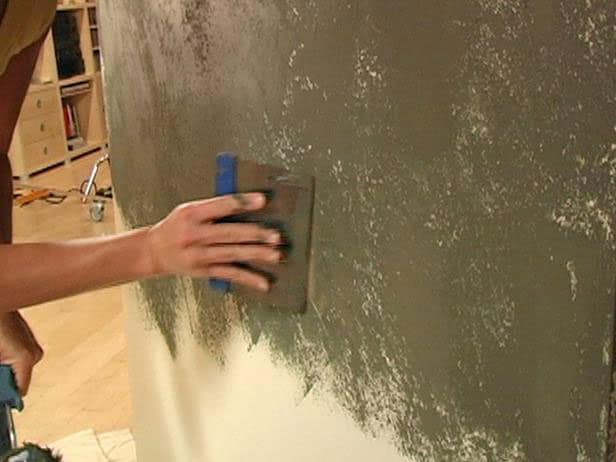Thick paint can be a real problem. It can make your painting project a lot more difficult, time-consuming, and frustrating.
Thick paint takes forever to dry, not to mention it will cause ridges, lumpiness, or weird orange peel-like cratering effect.
If you are using a paint sprayer, thick paint can ruin your day, your project, and your sprayer.
Spot and fix your thick paint issue with this go-to guide.

How do I know if I have a thick paint problem before I start?
Paint typically comes with instructions on the packaging that inform you if it can be used in a paint sprayer.
Many paints will require thinning to be used in a sprayer, but a roll or brush paint jobs usually don’t.
Stir the paint first, and then see how it runs off the stir stick. You want paint that has the consistency of heavy cream. Thick paint will be easily spotted by coming off in globs rather than running off smoothly.
I’m all about that DIY. How do I thin paint myself?
Decreasing the thickness, or the viscosity of your paint is not a difficult process. Thickening it back up is tougher, though, so be careful not to overdo it.
You want to thin all of the paint at once or in as few batches as possible to avoid inconsistent results.
For latex and acrylic paint, follow these steps:
- Pour the paint into a large bucket. (A five-gallon bucket should work for most projects).
- Remove any dry paint globs or chunks by pouring it through a sieve or mesh.
- For each gallon of paint, add a half cup of room temperature water.
- Stir thoroughly until all the water is mixed into the paint.
- Check the paint by running it off the stir stick again and checking if it flows freely through a funnel.
- Add more water if needed.
For Oil-based paint:
Since water and oil don’t mix, use turpentine or mineral spirits instead of water.
We recommend wearing gloves and being aware that oil based paint is messy and cannot be cleaned off containers, stir sticks, etc.
- Pour the paint into a container using mesh to strain out any debris.
- For every 3 parts of paint, add one part turpentine or mineral spirits.
- Stir thoroughly until all the paint is well mixed.
- Test the paint by brushing a test surface.
- Add more thinner if needed.

Old paints can come back to life using these methods, but should definitely be patch tested to make sure they can make it through your whole project.
It is highly suggested to stir and sieve old paints before attempting to thin them. This will save you time and make it known if the paint is too dried out or clumped to work with.
How to identify thick paint issues as you’re painting, or after it’s dry.
Thick paint will clog your paint sprayer and clump up.
If you notice that your sprayer is shooting spurts of paint unevenly, stop and check if you’re using overly thick paint.
In this case, you should also clear out the sprayer nozzle and double check that you are using the correct nozzle size for the job.
Paint issues once applied:
Runs / Drips
Applying too much paint at once will cause the paint to run because it cannot support its weight while still drying.
Make sure you are not laying on thick paint.
If using a brush or roller, check that you don’t have too much paint on it at once; paint should be plentifully coating the brush or roller, but not dripping off.
Trouble Drying
If your latex paint is taking more than an hour or two to be dry to the touch, you may be applying too thick paint coats. You can apply another coat after about four hours.
Oil based paint takes longer to dry to the touch, typically six to eight hours and you should wait 16 hours before re-coating.
This may not be the best news for your patience, but your perfect paint job will thank you later.
“Alligatoring”
When thick paint is applied or recoated without enough drying time, it can clump up into pieces that look like alligator scales.
This is desirable for almost no one, unless perhaps you are a reptile fanatic- in that case, good for you!
So, make sure you start with a clean surface, use a thinner on thick paint, and leave enough drying time between coats.
Wrinkling
Paint wrinkles when it is applied in excessively thick layers or is applied in very hot or cold temperatures.
Wrinkled paint creates a rough crinkle because the very top layer forms a film that dries before the rest of the paint.
Sagging
Paint that droops down with gravity immediately after application is a result of paint applied much too thickly or paint that has been over-thinned.
This can also be a result of painting in too high levels of humidity.

How to set yourself up for success and avoid thick paint problems:
Clean
Before any painting job, thoroughly clean, sand, and prime the surface appropriately.
Painting over moist, dusty, greasy, or otherwise dirty surfaces can cause blistering, cracking, flaking, or foaming of the paint. Make sure your surface is clean and dry before you begin.
Light It Up
It may sound obvious, but do not forget to light the area you’re painting very well. It will make a big difference in the evenness of your coats and help you notice any problem areas – ideally before they dry.
Work lights can be extremely handy, especially for indoor paint jobs.
Prime
Use a primer to ensure proper adhesion of the paint and increase paint durability.
When painting over an already existing color, make sure your new paint is compatible and will stick. If not, you may need to remove the existing paint with a chemical paint remover or by sanding it.
If you’re painting over a vibrant or dark color, you will likely need an undercoat to ensure full coverage of the paint and maintain the integrity of your new color.
Forecast
Check the weather. Keep in mind that conventional latex paints dry best in temperatures between 50 and 80 degrees Farenheight.
Moisture and paint are not friends. Your whole paint job could be a waste if the paint is rained on or it is too humid.
It also may all be for nothing if you paint in a poorly ventilated space or it is too cold. Make sure to plan ahead for best results.
Get Your Goods
Many projects, whether professional or DIY, face unexpected challenges. Think your project through.
Make sure you get enough self-protection, such as face masks, goggles, gloves, and coveralls.
Load up on paint and any necessary primers, undercoats, or thinners.
Pick the best paint sprayer you can for the job.
Get plenty of brushes, even if you are using a paint sprayer, to get into those tight corners or for any necessary touch ups.
If you are using a roller, do you need an extending pole for your project?
Purchase enough paint mixing containers, stir sticks, and trays.
Get a safe, sturdy ladder if you are painting anything high up. As a quick reminder, be cautious and smart when using a ladder.
Cover Up
Prep the area you are painting thoroughly. Tape and cover floors, furniture, trims, and anything else you don’t want paint to get on.
Spending the extra time taping and protecting windows, moving furniture or valuables, and covering any not to be painted space will help you paint with confidence.
Even the steadiest hand can make a mistake, so it is better to be safe than sorry.

If you are painting a ceiling, it can be easiest to paint first. This way, any overspray will fall onto the walls.
Some painters opt for a roller for the ceiling, but sprayers are faster and work much better on textured ceilings.
Choosing the right tool for your project depends on a ton of factors, such as your ceiling height and if you are painting the ceiling a different color than the walls.
Let the ceiling dry completely, then tape and cover it before moving onto the walls for most professional looking results.
Test
Always test a patch on any large paint job to ensure you are happy with the color, sheen, and texture of your paint before committing it to an entire table, wall, or room.
It is best to test paint fully and thoroughly and paint it as you will for the rest of the project.
Clean and prime the test area. You’re also trying to find the perfect number of coats to make sure you love the results before moving forward.
In addition to testing the surface, you will be painting, test out your tools. High-quality brushes and rollers can make a world of difference.
Know your tools and hone your technique
Get to know your paint sprayer well and map out how you plan to tackle your project.
Paint systematically.
For example, it is best to paint from one side of a wall to the other in the same order for every coat. This ensures best drying times and keeps you organized so that your coats turn out even.
Start in a corner and paint or spray in a back-and-forth motion, overlapping about half of each stroke pattern with every new one.
Particularly when using a paint sprayer, avoid arching at the end of your strokes.
Decide whether to paint the surface horizontally or vertically, depending on the project and your preference.
Painting layers in a perpendicular pattern – that is, switching between horizontal and vertical every layer, can have good results in certain projects requiring thick coverage.
Choose the right amount of pressure: Most paint sprayers have a flow knob or similar adjustable feature to let you customize the amount of force with which the paint is sprayed.
Paint sprayers with more horsepower will spray paint at a faster rate, resulting in thicker coats and decreased painting time.
Test out your sprayer with each new paint to work out things such as how far to be from the surface you are painting.
It is most commonly recommended to be six to twelve inches away from the surface, but check the instructions for your paint and tool, as well as test it out to get the desired effect.
If you do notice a minor problem while painting, such as drips, have a brush handy whether you are painting with a brush, roller, or paint sprayer.
If working with a sprayer, brush drips out as soon as you notice them and immediately spray lightly over the brush marks to cover them.
In Conclusion
Many painters run into the same common issues, whether they are professionals or do it yourself-ers.
Painting an item, accent wall, room, or even the exterior of your house can be a rewarding process for a homeowner.
That being said, for some homeowners, hiring a professional painter is a much more rewarding process.
Whatever the size of your painting project, knowing how to deal with common paint issues, such as how to identify and address problems related to thick paint, will get you a step ahead of the game.
Want to know more about paint sprayers specifically? Check out Tool Nerds’ other paint sprayer articles here.
Now that you have all of your thick paint questions answered, it’s time to get painting!










